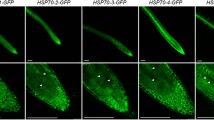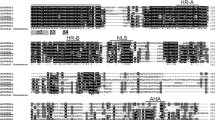Abstract
Based on phylogeny of DNA-binding domains and the organization of hydrophobic repeats, two families of heat shock transcription factors (HSFs) exist in plants. Class A HSFs are involved in the activation of the heat shock response, but the role of class B HSFs is not clear. When transcriptional activities of full-length HSFs were monitored in tobacco protoplasts, no class B HSFs from soybean or Arabidopsis showed activity under control or heat stress conditions. Additional assays confirmed the finding that the class B HSFs lacked the capacity to activate transcription. Fusion of a heterologous activation domain from human HSF1 (AD2) to the C-terminus of GmHSFB1-34 gave no evidence of synergistic enhancement of AD2 activity, which would be expected if weak activation domains were present. Furthermore, activity of AtHSFB1-4 (class B) was not rescued by coexpression with AtHSFA4-21 (class A) indicating that the class A HSF was not able to provide a missing function required for class B activity. The transcriptional activation potential of Arabidopsis AtHSFA4-21 was mapped primarily to a 39 amino acid fragment in the C-terminus enriched in bulky hydrophobic and acidic residues. Deletion mutagenesis of the C-terminal activator regions of tomato and Arabidopsis HSFs indicated that these plant HSFs lack heat-inducible regulatory regions analogous to those of mammalian HSF1. These findings suggest that heat shock regulation in plants may differ from metazoans by partitioning negative and positive functional domains onto separate HSF proteins. Class A HSFs are primarily responsible for stress-inducible activation of heat shock genes whereas some of the inert class B HSFs may be specialized for repression, or down-regulation, of the heat shock response.
Similar content being viewed by others
References
Baler, R., Dahl, G. and Voellmy, R. 1993. Activation of human heat shock genes is accompanied by oligomerization, modification, and rapid translocation of heat shock transcription factor HSF1. Mol. Cell. Biol. 13: 2486–2496.
Boscheinen, O., Lyck, R., Queitsch, C., Treuter, E., Zimarino, V. and Scharf, K.-D. 1997. Heat stress transcription factors from tomato can functionally replace HSF1 in the yeast Saccharomyces cerevisiae. Mol. Gen. Genet. 255: 322–331.
Chevray, P.M. and Nathans, D. 1992. Protein interaction cloning in yeast: identification of mammalian proteins that react with the leucine zipper of Jun. Proc. Natl. Acad. Sci. USA 89: 5789–5793.
Christensen, A.H. and Quail, P.H. 1996. Ubiquitin promoter-based vectors for high-level expression of selectable and/or screenable marker genes in monocotyledonous plants. Transgenic Res. 5: 213–218.
Czarnecka-Verner, E. and Gurley, W.B. 1999. Plant heat shock transcription factors: divergence in structure and function. Biotechnologia 3: 125–142.
Czarnecka-Verner, E., Yuan, C.-X., Fox, P.C. and Gurley, W.B. 1995. Isolation and characterization of six heat shock transcription factor cDNA clones from soybean. Plant Mol. Biol. 29: 37–51.
Czarnecka-Verner, E., Yuan, C.-X., Nover, L., Scharf, K.-D., Englich, G. and Gurley, W.B. 1997. Plant heat shock transcription factors: positive and negative aspects of regulation. Acta Physiol. Plant. 19: 529–537.
Czarnecka-Verner, E., Pan, S., Yuan, C.-X. and Gurley, W.B. in press. Functional specialization of plant Class A and B HSFs. In: J. Cherry (Ed.) Plant Tolerance to Abiotic Stresses in Agriculture: Role of Genetic Engineering.
Fiorenza, M.T., Farkas, T., Dissing, M., Kolding, D. and Zimarino, V. 1995. Complex expression of murine heat shock transcription factors. Nucl. Acids Res. 23: 467–474.
Gagliardi, D., Breton, C., Chaboud, A., Vergne, P. and Dumas, C. 1995. Expression of heat shock factor and heat shock protein 70 genes during maize pollen development. Plant Mol. Biol. 29: 841–856.
Gallo, G.J., Prentice, H. and Kingston, R.E. 1993. Heat shock factor is required for growth at normal temperatures in the fission yeast Schizosaccharomyces pombe. Mol. Cell. Biol. 13: 749–761.
Green, M., Schuetz, T.J., Sullivan, E.K. and Kingston, R.E. 1995. A heat shock-responsive domain of human HSF1 that regulates transcription activation domain function. Mol. Cell. Biol. 15: 3354–3362.
Hübel, A., Lee, J.H., Wu, C. and Schöffl, F. 1995. Arabidopsis heat shock factor is constitutively active in Drosophila and human cells. Mol. Gen. Genet. 248: 136–141.
Hübel, A. and Schöffl, F. 1994. Arabidopsis heat shock factor: isolation and characterization of the gene and the recombinant protein. Plant Mol. Biol. 26: 353–363.
Hull, G.A. Devic, M. 1995. The β-glucuronidase (GUS) reporter gene system. In: H. Jones (Ed.) Plant Gene Transfer and Expression Protocols, Humana Press, Totowa, NY, pp. 125–141.
Jedlicka, P., Mortin, M.A. and Wu, C. 1997. Multiple functions of Drosophila heat shock transcription factor in vivo. EMBO J. 16: 2452–2462.
Jurivich, D.A., Sistonen, L., Kroes, R.A. and Morimoto, R.I. 1992. Effect of sodium salicylate on the human heat shock response. Science 255: 1243–1245.
Lin, Y.S., Carey, M.F., Ptashne, M. and Green, M.R. 1988. GAL4 derivatives function alone and synergistically with mammalian activators in vitro. Cell 54: 659–664.
Lyck, R., Harmening, U., Hohfeld, I., Treuter, E., Scharf, K.D. and Nover, L. 1997. Intracellular distribution and identification of the nuclear localization signals of two plant heat-stress transcription factors. Planta 202: 117–125.
Ma, J., Przibilla, E., Hu, J., Bogorad, L. and Ptashne, M. 1988. Yeast activators stimulate plant gene expression. Nature 334: 631–633.
McMillan, D.R., Xiao, X., Shao, L., Graves, K. and Benjamin, I.J. 1998. Targeted disruption of heat shock transcription factor 1 abolishes thermotolerance and protection against heat-inducible apoptosis. J. Biol. Chem. 273: 7523–7528.
Nakai, A., Kawazoe, Y., Tanabe, M., Nagata, K. and Morimoto, R.I. 1995. The DNA-binding properties of two heat shock factors, HSF1 and HSF3, are induced in the avian erythroblast cell line HD6. Mol. Cell. Biol. 15: 5268–5278.
Nakai, A. Morimoto, R.I. 1993. Characterization of a novel chicken heat shock transcription factor, heat shock factor 3, suggests a new regulatory pathway. Mol. Cell. Biol. 13: 1983–1997.
Nakai, A., Tanabe, M., Kawazoe, Y., Inazawa, J., Morimoto, R.I. and Nagata, K. 1997. HSF4, a new member of the human heat shock factor family which lacks properties of a transcriptional activator. Mol. Cell. Biol. 17: 469–481.
Nakayama, T., Ito, T. and Iwabuchi, M. 1995. Trans-activation of the wheat histone H3 promoter by Gal4 DNA-binding domain (1-94) in plant cells. Biochim. Biophys. Acta 1263: 281–284.
Newton, E.M., Knauf, U., Green, M. and Kingston, R.E. 1996. The regulatory domain of human heat shock factor 1 is sufficient to sense heat stress. Mol. Cell. Biol. 16: 839–846.
Nover, L. and Scharf, K.-D. 1997. Heat stress proteins and transcription factors. Cell. Mol. Life Sci. 53: 80–103.
Nover, L., Scharf, K.-D., Gagliardi, D., Vergne, P., Czarnecka-Verner, E. and Gurley, W.B. 1996. The Hsf world: classification and properties of plant heat stress transcription factors. Cell Stress Chaperones 1: 215–223.
Prändl, R., Hinderhofer, K., Eggers-Schumacher, G. and Schöffl, F. 1998. HSF3, a new heat shock factor from Arabidopsis thaliana, derepresses the heat shock response and confers thermotolerance when overexpressed in transgenic plants. Mol. Gen. Genet. 258: 269–278.
Sarge, K.D., Murphy, S.P. and Morimoto, R.I. 1993. Activation of heat shock gene transcription by heat shock factor 1 involves oligomerization, acquisition of DNA binding activity, and nuclear localization and can occur in the absence of stress. Mol. Cell. Biol. 13: 1392–1407.
Scharf, K.D., Heider, H., Hohfeld, I., Lyck, R., Schmidt, E. and Nover, L. 1998. The tomato Hsf system: HsfA2 needs interaction with HsfA1 for efficient nuclear import and may be localized in cytoplasmic heat stress granules. Mol. Cell Biol. 18: 2240–2251.
Scharf, K.-D., Rose, S., Zott, W., Schöffl, F. and Nover, L. 1990. Three tomato genes code for heat stress transcription factors with a region of remarkable homology to the DNA-binding domain of the yeast HSF. EMBO J. 9: 4495–4501.
Shi, Y., Kroeger, P.E. and Morimoto, R.I. 1995. The carboxylterminal transactivation domain of heat shock factor is negatively regulated and stress responsive. Mol. Cell. Biol. 15: 4309–4318.
Sistonen, L., Sarge, K.D. and Morimoto, R.I. 1994. Human heat shock factors 1 and 2 are differentially activated and can synergistically induce hsp70 gene transcription. Mol. Cell. Biol. 14: 2087–2099.
Sistonen, L., Sarge, K.D., Phillips, B., Abravaya, K. and Morimoto, R.I. 1992. Activation of heat shock factor 2 during hemin-induced differentiation of human erythroleukemia cells. Mol. Cell. Biol. 12: 4104–4111.
Sorger, P.K. and Pelham, H.R.B. 1988. Yeast heat shock factor is an essential DNA-binding protein that exhibits temperaturedependent phosphorylation. Cell 54: 855–864.
Tanabe, M., Nakai, A., Kawazoe, Y. and Nagata, K. 1997. Different thresholds in the responses of two heat shock transcription factors, HSF1 and HSF3. J. Biol. Chem. 272: 15389–15395.
Treuter, E., Nover, L., Ohme, K. and Scharf, K.-D. 1993. Promoter specificity and deletion analysis of three heat stress transcription factors of tomato. Mol. Gen. Genet. 240: 113–125.
Yuan, C.-X. 1996. Function and regulation of human and soybean heat shock transcription factors expressed in yeast and HeLa cells. Ph.D. dissertation, University of Florida.
Czarnecka-Verner, E. and Gurley, W.B. 1997. Expression of human heat shock transcription factors 1 and 2 in HeLa cells and yeast. Cell Stress Chaperones 2: 263–275.
Zuo, J., Rungger, D. and Voellmy, R. 1995. Multiple layers of regulation of human heat shock transcription factor 1.Mol. Cell. Biol. 15: 4319–4330.
Author information
Authors and Affiliations
Rights and permissions
About this article
Cite this article
Czarnecka-Verner, E., Yuan, CX., Scharf, KD. et al. Plants contain a novel multi-member class of heat shock factors without transcriptional activator potential. Plant Mol Biol 43, 459–471 (2000). https://doi.org/10.1023/A:1006448607740
Issue Date:
DOI: https://doi.org/10.1023/A:1006448607740




